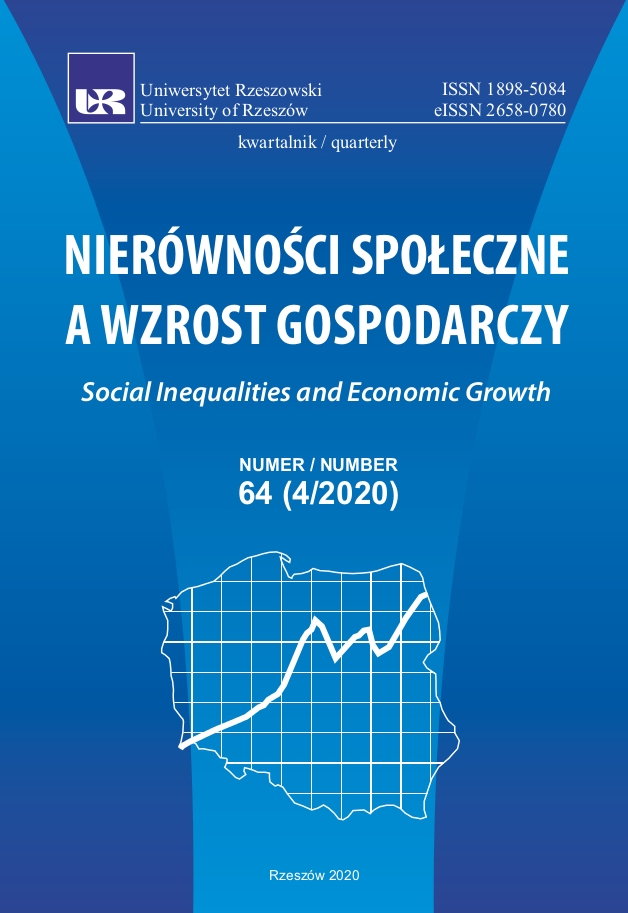Human capital resources in northern Poland
DOI:
https://doi.org/10.15584/nsawg.2020.4.9Keywords:
education, human capital, education outputs, northern PolandAbstract
For the purposes of this study it was assumed that human capital is: knowledge, skills, competences and other features embodied in man, which are associated with his economic activity. The main purpose of this study was to identify the state and changes in human capital resources in northern Poland and to present their spatial diversity using hierarchical agglomeration techniques. The research concerned northern Poland, understood for the purposes of this study as two voivodships, i.e. the Pomorskie and the Zachodniopomorskie voivodeships, each divided into poviats. The source material came from the published and unpublished statistical materials of the Central Statistical Office. In turn, the resources of the Central Examination Board and the Regional Examination Boards in Gdańsk and Poznań were used to develop school educational results. The time range of the study was the years 1999–2018. The research clearly shows that the role of human capital resources in northern Poland is increasing. On the one hand this is the result of the growing number of people with the highest levels of education, and on the other the growing social awareness that increases in quality and living conditions largely depends on self-investment. The change in life attitudes of young people, who are increasingly gambling on achieving higher education, has been confirmed by the growing number of students and changes in education. In addition, the introduction to the higher education sector of non-public universities and the education of academic functions in sub-regional centers has increased the spatial accessibility to education, primarily for the residents of peripheral regions. However, the distribution of human capital resources in the studied area is characterized by relatively strong polarization with a distinct distance between the Tri-City and Szczecin agglomerations, which was confirmed by the classification of poviats using agglomeration techniques. The disparities in the level of education in northern Poland are to a large extent the heritage of the socialized sector in agriculture. Post-farming areas form depopulation areas with unfavorable socio-economic conditions, where parents attach less importance to the education of their children. However, the positive effect of the ongoing changes is the involvement of human capital with a high level of education in research and development activities. Research shows that regions with a higher level of education and socio-economic development are characterized by greater wealth expressed in terms of GDP per capita.
Downloads
References
Becker, G. S. (1962). Investment in Human Capital: a theoretical Analysis. The Journal of Political Economy, LXX, Supplement, 9–49. DOI: 10.1086/258724.
Chojnicki, Z., Czyż, T. (2007). Rola kapitału ludzkiego w kształtowaniu gospodarki opartej na wiedzy w Polsce. Przegląd Geograficzny 79(3–4), 423–438.
Dokurno, Z. (2017). Modelowanie kapitału ludzkiego w gospodarce opartej o wiedzę. Warszawa: Państwowe Wydawnictwo Naukowe.
Gaczek, W. M., Komorowski, J. (2005). Kapitał ludzki i społeczny regionu jako element rozwoju gospodarki opartej na wiedzy. Zeszyty Naukowe Akademii Ekonomicznej, 57, 51–80.
Herbst, M. (red.). (2007). Kapitał ludzki i kapitał społeczny a rozwój regionalny. Warszawa: Wydawnictwo Naukowe Scholar.
Herbst, M. (2004). Zróżnicowanie jakości kapitału ludzkiego w Polsce. Od czego zależą wyniki edukacyjne? Studia Regionalne i Lokalne, 3(17), 89–104.
Jabłoński, Ł. (2012). Kapitał ludzki a konwergencja gospodarcza. Warszawa: Wydawnictwo C.H. Beck.
Janc, K. (2009). Zróżnicowanie przestrzenne kapitału ludzkiego i społecznego w Polsce. Rozprawy Naukowe Instytutu Geografii i Rozwoju Regionalnego Uniwersytetu Wrocławskiego, 8. Wrocław: Uniwersytet Wrocławski.
Jaźwiński, I. (2017). Kapitał ludzki w polityce regionalnej. Szczecin: Wydawnictwo Naukowe Uniwersytetu Szczecińskiego.
Jażewicz, I. (2011). Przekształcenia regionalnych struktur funkcjonalno-przestrzennych. Współczesne kierunki przemian społeczno-ekonomicznych. W: B. Namyślak (red.), Kapitał ludzki w małych miastach województwa pomorskiego (s. 203–214). Rozprawy Naukowe Instytutu Geografii i Rozwoju Regionalnego Uniwersytetu Wrocławskiego, 19. Wrocław: Uniwersytet Wrocławski.
Kamińska, W. (2011). Kapitał ludzki i społeczny na obszarach wiejskich w Polsce. Przykład województwa świętokrzyskiego. Kielce: Uniwersytet Humanistyczno-Przyrodniczy im. Jana Kochanowskiego.
Kamińska, W., Heffner, K. (red.). (2010). Kapitał ludzki i społeczny w procesie rozwoju obszarów wiejskich. Studia KPZK PAN, 126, s. 1–251.
Lucas, R. E. (1988). On the Mechanics of Economic Development. Journal of Monetary Economics, 22, 23–44.
Nowak, E. (1990). Metody taksonomiczne w klasyfikacji obiektów społeczno-gospodarczych. Warszawa: Państwowe Wydawnictwo Naukowe.
Panek, E. (red.). (2007). Kapitał ludzki i wiedza w gospodarce. Wyzwania XXI wieku. Poznań: Wydawnictwo Akademii Ekonomicznej.
Roczniki Statystyczne Województw. (2002). Warszawa: GUS. Roczniki Statystyczne Województw. (2011). Warszawa: GUS.
Roszkowska, S. (2013). Kapitał ludzki a wzrost gospodarczy. Łódź: Wydawnictwo Naukowe Uniwersytetu Łódzkiego.
Romer, P. M. (1994). The Origins of Endogenous Growth. Journal of Economic Perspectives, 8, 3–22. DOI: 10.1257/jep.8.1.3.
Rydz, E. (2002). Bariery edukacyjne młodzieży wiejskiej. Studia Obszarów Wiejskich, 2, 53–68. Skrodzka, I. (2015). Kapitał ludzki polskich województw – koncepcja pomiaru. Białystok: Wydawnictwo Uniwersytetu w Białymstoku.
Skrzypek, E., Sokół, A. (red.). (2009). Zarządzanie kapitałem ludzkim w gospodarce opartej na wiedzy. Warszawa: Instytut Wiedzy i Innowacji.
Smith, A. (1954). Badania nad naturą i przyczynami bogactwa narodów. Warszawa: Powszechne Wydawnictwo Naukowe.
Wronowska, G. (2012). Kapitał ludzki: ujęcie teoretyczne. Kraków: Wydawnictwo Uniwersytetu Ekonomicznego.
Zdrojewski, E. Z. (2012). Przemiany demograficzne Pomorza na przełomie wieków – ujęcie przestrzenne, społeczne, przestrzenne. W: P. Szmielińska-Pietraszek, W. Szymańska (red.), Rozwój kapitału ludzkiego w miastach i na wsi (s. 19–38). Słupsk–Warszawa: Akademia Pomorska.
Downloads
Published
How to Cite
Issue
Section
License
Copyright (c) 2020 University of Rzeszow

This work is licensed under a Creative Commons Attribution-ShareAlike 4.0 International License.


